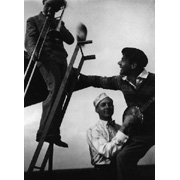|
 Three
Members of the Bauhaus Band with Ladder, ca. 1928 Three
Members of the Bauhaus Band with Ladder, ca. 1928
Gelatin silver print
11.3 x 8.3 cm (4-15/32, x 3-1/4 in.)
85.XP.384.94
American jazz was a significant influence on European
artists, especially students at the Bauhaus, where Moholy-Nagy's (related to-->> 141-42)
polyvalent approach encom- passed raw materials that ranged from pure light to
pure sound. T. Lux, son of the painter Lyonel Feininger, was steered away from
photography by his father while a student at the Bauhaus, but he was drawn back
to it by Moholy, who lectured that photography was a powerful tool for the artist
and who urged his students to teach themselves and experiment with it. Operating
in the spirit of the inspired amateur, Feininger studied the social dynamics of
his school pals as they learned to cope in the Jazz Age. He used a highly flexible
handheld camera to achieve maximum spontaneity in keeping with the subject represented;
his picture is in striking contrast to the Constructivist abstractions of Moholy,
Rodchenko, and El Lissitzky, which reptesent the high-art branch of experimental
photography in the 1920s. The traditional distinction between teacher and student
was dissolved at the Bauhaus, and so too was the hierarchy of materials, thus
allowing a snapshot to be as worthy of serious regard as an oil painting or a
carefully composed abstract photographic image.
|